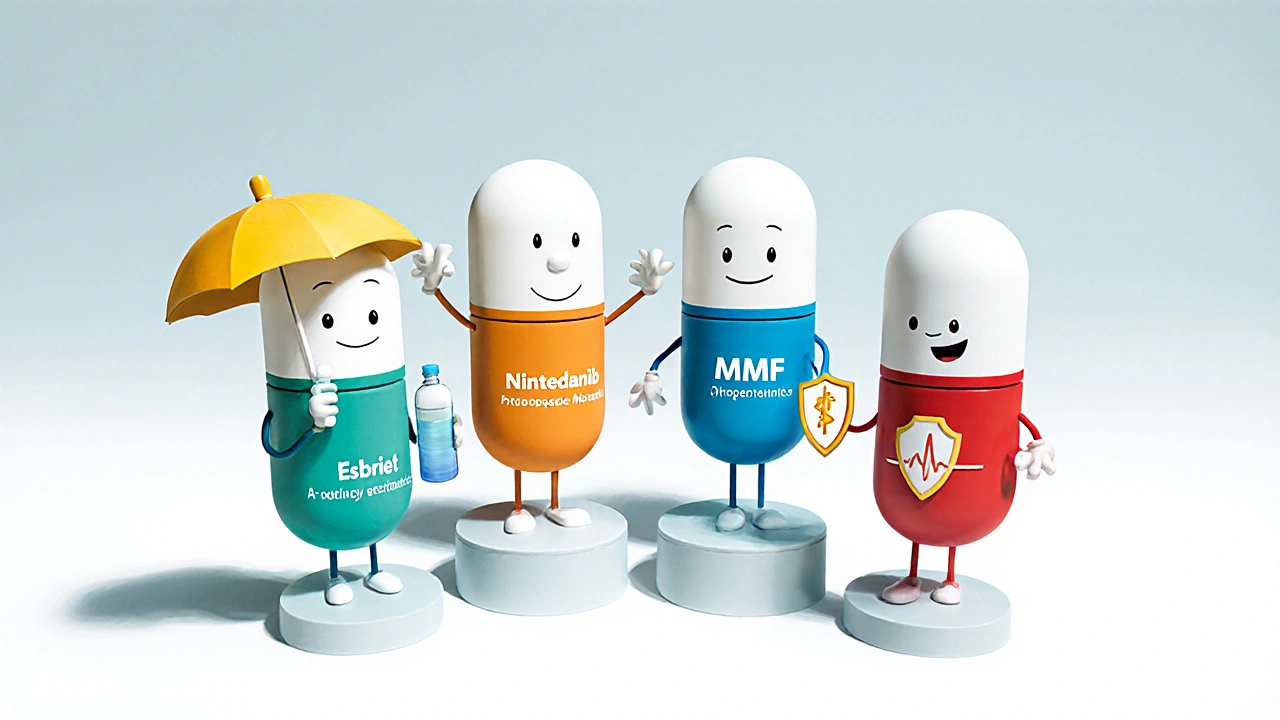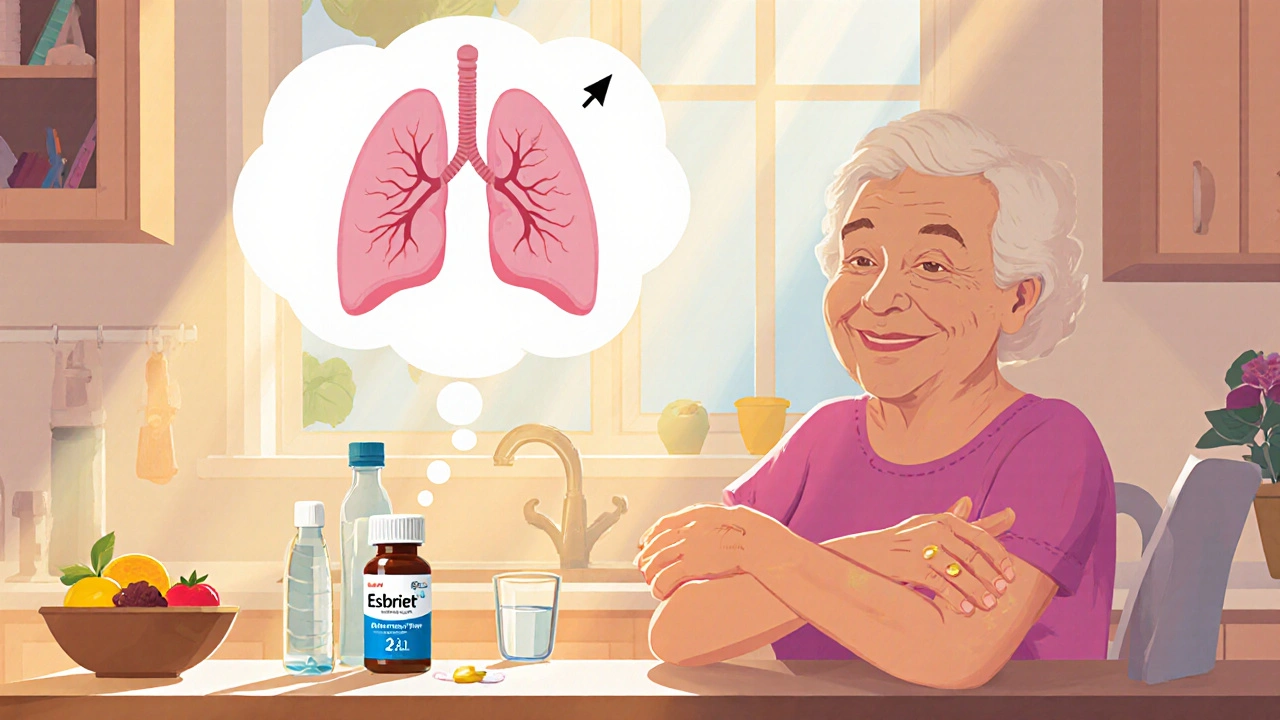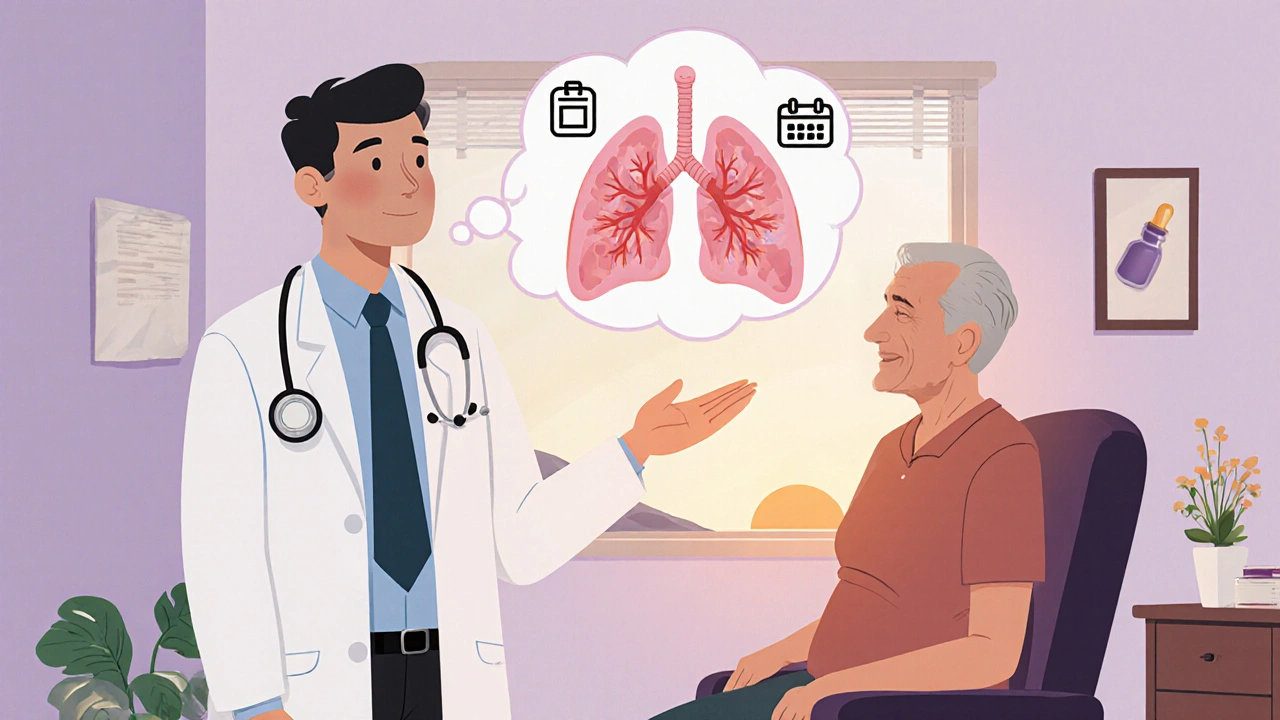When you or a loved one is diagnosed with idiopathic pulmonary fibrosis (IPF), the first question is usually “which drug works best?” Esbriet (pirfenidone) has been on the market for over a decade, but newer options like nintedanib and several off‑label choices are now competing for a spot in treatment plans. This guide walks through the science, dosing, side‑effects, costs and real‑world outcomes so you can see how Esbriet stacks up against its alternatives.
What is Idiopathic Pulmonary Fibrosis?
Idiopathic Pulmonary Fibrosis is a chronic, progressive lung disease characterized by scarring (fibrosis) of the interstitial tissue, which leads to a steady decline in lung capacity and, ultimately, respiratory failure. The cause is unknown, hence “idiopathic.” Typical patients are older adults (median diagnosis age ~70) and the disease incurs a median survival of 3‑5 years without treatment. Early intervention with antifibrotic agents can slow the decline in forced vital capacity (FVC) by 40‑50% according to pivotal trials.
Esbriet (Pirfenidone) - The Original Antifibrotic
Esbriet (generic name pirfenidone) is an oral antifibrotic approved by the FDA in 2014 and by the EMA in 2011. It works by inhibiting transforming growth factor‑β (TGF‑β) signaling and reducing collagen synthesis, which collectively slows scar formation.
- Dosage: 801mg three times a day (total 2403mg) after a 2‑week titration period.
- Efficacy: The CAPACITY and ASCEND trials showed a 48% reduction in the proportion of patients experiencing a ≥10% decline in FVC over 1year.
- Common side‑effects: Nausea, dyspepsia, photosensitivity rash, and mild elevation of liver enzymes.
- Monitoring: Baseline and quarterly liver function tests; advise sun protection.
- Cost (Australia 2025): Approximately AU$190 per month on the PBS, with possible subsidies for eligible patients.
Alternative #1 - Nintedanib (Ofev)
Nintedanib (brand name Ofev) is a tyrosine‑kinase inhibitor that blocks multiple growth factor receptors involved in fibroblast proliferation. It received FDA approval in 2014, the same year as Esbriet, and is often the first-line alternative.
- Dosage: 150mg twice daily with food.
- Efficacy: INPULSIS‑1 and ‑2 trials reported a 49% reduction in annual FVC decline, essentially matching Esbriet’s performance.
- Common side‑effects: Diarrhea (up to 70% of patients), nausea, and liver enzyme elevation.
- Monitoring: Liver function tests at baseline, then every 3months; watch for severe diarrhea and dehydration.
- Cost (Australia 2025): Around AU$250 per month on the PBS, slightly higher than Esbriet.
Alternative #2 - Off‑Label Use of Mycophenolate Mofetil
Mycophenolate mofetil (MMF) is an immunosuppressant primarily used in organ transplantation. Small open‑label studies suggest it may stabilize lung function in mild‑to‑moderate IPF when patients cannot tolerate the approved antifibrotics.
- Dosage: 1500mg twice daily.
- Efficacy: Retrospective analyses show a modest 20‑30% slowing of FVC decline, but data remain limited.
- Side‑effects: GI upset, leukopenia, and increased infection risk.
- Monitoring: Full blood count monthly, renal function quarterly.
- Cost: Approximately AU$70 per month, making it the cheapest option but also the least evidence‑based.

Alternative #3 - Sildenafil (Revatio) - A Symptomatic Approach
Sildenafil, a phosphodiesterase‑5 inhibitor, is approved for pulmonary arterial hypertension. Some clinicians prescribe it off‑label for IPF‑associated pulmonary hypertension, aiming to improve exercise capacity rather than directly halt fibrosis.
- Dosage: 20mg three times daily.
- Efficacy: Trials show modest improvements in 6‑minute walk distance but no effect on FVC.
- Side‑effects: Headache, flushing, visual disturbances.
- Monitoring: Blood pressure, visual changes.
- Cost: About AU$30 per month.
How to Choose the Right Drug - Decision Criteria
Picking an antifibrotic isn’t just about the headline efficacy numbers. Below is a quick decision matrix that many pulmonologists use during consultations.
| Attribute | Esbriet (Pirfenidone) | Nintedanib (Ofev) | Mycophenolate Mofetil | Sildenafil (Revatio) |
|---|---|---|---|---|
| Mechanism | Inhibits TGF‑β, reduces collagen | Tyrosine‑kinase inhibition (FGFR, PDGFR) | Immunosuppression (purine synthesis) | PDE‑5 inhibition (vasodilation) |
| Annual FVC decline reduction | ≈48% | ≈49% | ≈20‑30% (variable) | None (symptomatic) |
| Common side‑effects | Photosensitivity, GI upset, liver ↑ | Diarrhea, nausea, liver ↑ | GI upset, leukopenia, infection | Headache, flushing, visual changes |
| Monitoring needs | Liver tests q3‑months, sun protection | Liver tests q3‑months, manage diarrhea | CBC monthly, renal q3‑months | BP, vision, no labs needed |
| Monthly cost (AU$) | ≈190 (PBS) | ≈250 (PBS) | ≈70 (generic) | ≈30 (generic) |
| Approval year (Australia) | 2011 (PBS) | 2012 (PBS) | Off‑label | Off‑label for IPF‑PH |
Practical Tips for Starting an Antifibrotic
- Assess baseline liver function. Both Esbriet and Nintedanib can raise ALT/AST; a normal baseline reduces early stoppage.
- Discuss lifestyle adjustments. For Esbriet, sunscreen (SPF30+) is a must, while for Nintedanib you’ll want a diet high in fiber to combat diarrhea.
- Set realistic expectations. Expect a 30‑45% slowdown in disease progression, not a cure. Monitoring FVC every 6‑12months helps gauge response.
- Coordinate with a pharmacist. The PBS subsidy codes differ: Esbriet (PBS 1057) vs Nintedanib (PBS 1058). Correct coding avoids out‑of‑pocket spikes.
- Plan for side‑effect management. Antacids or PPIs help with Esbriet‑related dyspepsia; loperamide is often prescribed prophylactically for Nintedanib‑induced diarrhea.

When to Switch or Combine Therapies
Switching isn’t automatic. Consider a change when:
- Persistent liver enzyme elevation >3× ULN despite dose reduction.
- Unmanageable GI toxicity that impairs nutrition.
- FVC decline exceeds 10% in the first 6months, suggesting poor response.
Combination therapy (e.g., low‑dose pirfenidone + nintedanib) is still experimental; ongoing trials (INCREASE‑COMBO 2025) aim to clarify safety, but current guidelines advise against routine dual use outside a trial.
Bottom Line - Which Drug Fits You?
If you value a well‑established safety profile and can commit to diligent sun protection, Esbriet remains a solid first choice, especially when cost is a concern. If you anticipate trouble with photosensitivity or prefer a twice‑daily regimen, Nintedanib may feel easier, albeit at a higher price tag. For patients with mild disease who cannot tolerate either, MMF offers a cheaper, albeit less proven, alternative. And when pulmonary hypertension co‑exists, adding sildenafil can improve exercise capacity without affecting fibrosis.
Frequently Asked Questions
Can I take Esbriet and Nintedanib together?
At present, the combination is not approved. Clinical trials are exploring safety, but guidelines recommend using one drug at a time unless you are enrolled in a study.
What should I do if I develop a rash from Esbriet?
Stop sun exposure, use sunscreen, wear protective clothing, and contact your doctor. In many cases the rash improves without stopping the drug, but severe photosensitivity may require dose reduction or switching.
Is there any benefit to starting both drugs at a low dose?
Both medications have built‑in titration schedules (pirfenidone over 2weeks, nintedanib at full dose from day1). Starting both low doesn’t increase efficacy and may prolong side‑effect onset, so it’s not recommended.
How often should my lung function be tested?
Guidelines suggest spirometry every 6months after therapy initiation, with more frequent testing if you notice worsening symptoms.
Are there any dietary restrictions with these drugs?
Pirfenidone should be taken with food to lessen GI upset. Nintedanib also requires meals to reduce diarrhea. Avoid excessive alcohol while on either drug because it can worsen liver toxicity.


Nicola Strand
October 16, 2025 AT 13:02It is morally indefensible to prioritize cost over patient safety in the selection of antifibrotic therapy. While the guide presents a comparative table, the implicit suggestion that cheaper options such as mycophenolate should be considered on fiscal grounds alone betrays a troubling utilitarian mindset. The ethical responsibility of the prescriber is to first secure the most robust evidence‑based regimen, irrespective of price, and only then discuss subsidies or assistance programs. Moreover, the emphasis on photosensitivity as a minor inconvenience underestimates the potential for severe cutaneous reactions that can compromise adherence. Patients deserve a treatment plan anchored in efficacy and safety, not a budget spreadsheet.
Jackie Zheng
October 29, 2025 AT 19:14Reading through the pharmacological nuances reminded me that medicine, at its core, is a language of risk and reward. If we misuse the term “tolerable” without a strict grammatical definition, we risk misleading patients. Esbriet’s titration schedule, for instance, is not a mere suggestion; it is a carefully calibrated ladder designed to mitigate gastrointestinal upset. Nintedanib, on the other hand, demands a different culinary strategy-high‑fiber meals to counteract diarrhea. The juxtaposition of these regimens illustrates the classic dialectic between freedom and constraint, a theme philosophers have wrestled with for centuries. Yet, unlike Socratic dialogues, the clinical outcomes are measured in forced vital capacity, not abstract virtue. In short, choose the drug that aligns with your physiological constitution and your willingness to adhere to lifestyle modifications.
Jackie Berry
November 12, 2025 AT 02:26From a global health perspective, the decision between pirpirfenidone and nintedanib transcends the confines of a single clinic and touches on equity, accessibility, and cultural expectations. In many low‑ and middle‑income nations, the PBS‑derived prices quoted in the guide become abstract numbers, while out‑of‑pocket costs can cripple families. The fact that mycophenolate offers a sub‑AU$100 price point is not merely an economic footnote-it reflects a strategic compromise that some health systems have adopted out of necessity. Yet, this compromise must be weighed against the limited evidence base, which, as the article notes, hovers around a modest 20‑30% slowdown in FVC decline. Patients who cannot tolerate the photosensitivity of pirfenidone may find solace in the once‑daily regimen of nintedanib, provided they have reliable access to anti‑diarrheal agents. Conversely, those with pre‑existing hepatic concerns might prefer the drug with a slightly milder liver enzyme profile. Cultural attitudes toward medication also play an underrated role; in societies where sunlight is a daily ritual, the burden of stringent photoprotection could deter adherence to Esbriet. In contrast, regions where high‑fat diets are prevalent might exacerbate nintedanib‑related gastrointestinal distress, prompting clinicians to pre‑emptively prescribe dietary counseling. Furthermore, the emergence of combination trials, although still experimental, signals a future where the binary choice may dissolve into a more nuanced, patient‑centric algorithm. It is also worth noting that the psychosocial impact of an IPF diagnosis can influence drug acceptance; some patients view the act of “fighting” the disease through an aggressive therapeutic regimen as an affirmation of agency, while others prefer a gentler approach that aligns with their quality‑of‑life priorities. Ultimately, the prescribing clinician must engage in a shared decision‑making dialogue that respects both the biomedical data and the lived realities of the individual. By integrating cost considerations, side‑effect profiles, cultural context, and patient preferences, we move closer to a truly personalized order of care. The guide succeeds in laying out the raw data, but the art of medicine lies in weaving those data points into a narrative that resonates with each unique patient. Therefore, clinicians should remain vigilant, reassessing therapy choices as new evidence emerges and as patient circumstances evolve.
Mikayla May
November 25, 2025 AT 09:38Take your meds with food and keep a sunscreen handy.
Jimmy the Exploder
December 8, 2025 AT 16:50Esbriet is cheap its side effects are annoying but you can deal with them its just another drug